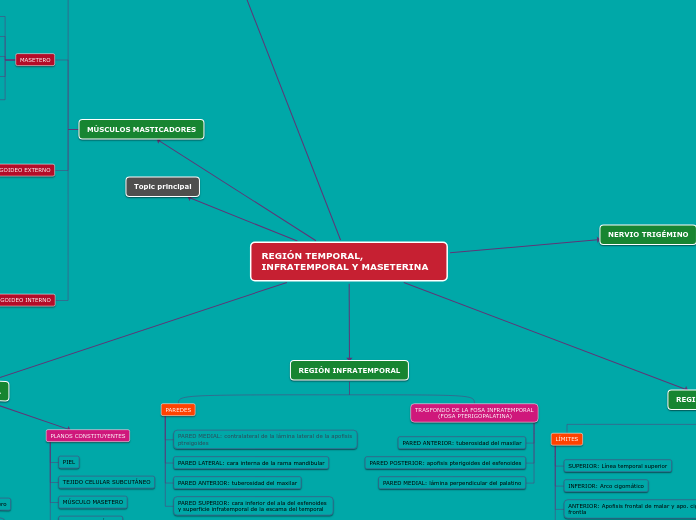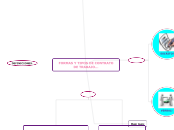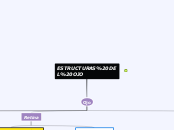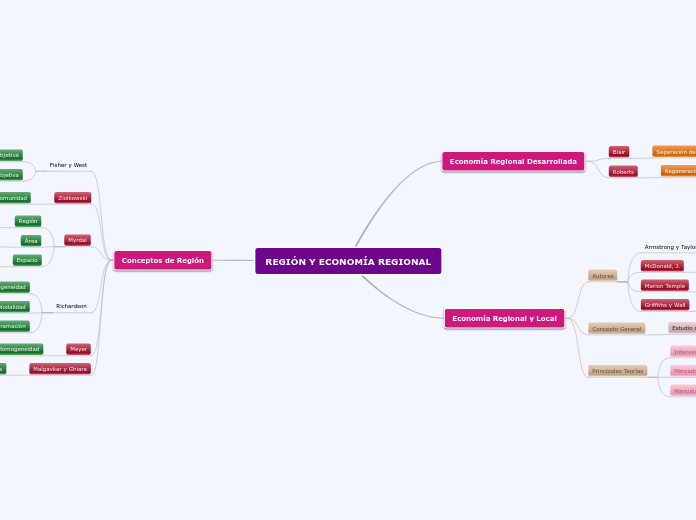Irrigan el cuero cabelludo
REGIÓN TEMPORAL, INFRATEMPORAL Y MASETERINA
Name the character
Type in the name of the character whose change throughout the story you are going to analyze.
Example: Nick Carraway.
REGIÓN TEMPORAL
Character's behavior
Think of the character's behavior at the beginning of the story and look for the way it changed throughout the story.
PLANOS
PLANO PROFUNDO:
-arterias y venas anterior y posterior
nervio anterior, medio y posterior
PLANO MEDIO:
-aponeurosis epicraneal
-músculos auriculares anterior y superior
-fascia y músculo temporal
PLANO SUPERFICIAL:
-piel cabelluda
-tejido subcutáneo
-vasos temproales
-nervio auriculotemporal
Change in behavior
How did the character change the first behavior you mentioned? Type in a quote to prove your statement.
Example: Nick assumes the whole responsibility for Gatsby's funeral arrangements, 'with that intense personal interest to which every one has some vague right at the end.'
POSTERIOR: frontal, ala mayor del esfenoides, parietal y porción escamosa del temporal
ANTERIOR: Apofisis frontal de malar y apo. cigomático del frontla
INFERIOR: Arco cigomático
Initial behavior
What is the character's behavior at the beginning of the story? Type in a relevant quote for your statement.
Example: Nick seems to be an honest person, calling himself 'one of the few honest people that I have ever known'.
SUPERIOR: Línea temporal superior
Initial behavior
How does the character act at the beginning of the story? Type in a relevant quote for your statement.
Example: Nick shows his immature side as he leaves to New York in order to avoid 'being rumored into marriage' with his girlfriend.
Topic principal
NERVIO TRIGÉMINO
RAMAS TERMINALES DEL GANGLIO TRIGEMINAL
NERVIO MANDIBULAR: sensitivo-motor
TRONCO POSTERIOR, TRONCO DE LOS TENSORES
N. LINGUAL: va dirección de la lengua. Recibe la cuerda del tímpano. El ganglio submandibular inerva con fibras vegetativas y sensitivas a las glándulas submandibular y sublingual
N. ALVEOLAR INFERIOR: conducto dentario y cuerpo de la mandíbula y llega al agujero mentoniano
-N. incisivo: para el canino e incisivos inferiores
-N. mentoniano: para la región mentoniana
N. AURICULOTEMPORAL: sale de la región infratemporal por el ojal retrocondileoy alcanza la región temporal e inerva el ATM.
N. MÚSCULO PTERIGOIDEO MEDIAL
N. MÚSCULO TENSOR DEL VELO DEL PALADAR: se origina en la fosita escafoidea y tensa el músc. velo del paladar
N. MÚSCULO TENSOR DEL TÍMPANO: va a tensar la membrana timpánica
TRONCO ANTERIOR
NERVIO TEMPOROMASETERO: da dos nervios: n. temporal profundo posteriorque inerva al temporal, y n. masetértico que inerva al músculo masetero
NERVIO TEMPORAL PROFUNDO MEDIO: inerva al músculo temporal
NERVIO TEMPOROBUCAL: va a dar dos nervios: n. temporal profundo anterior que inerva la región temporal, y n. bucal que inerva la piel de la mejilla
RAMO MENINGEO: va a la cavidad craneal por el foramen oval y el foramen espinoso, junto a la arteria meningea media
ORIGEN: en el ganglio de Gasser, sale por el foramen oval y alcanza la región infratemporal
NERVIO MAXILAR: sensitivo-motor
NERVIO INFRAORBITARIO
Sale por el agujero infraorbitario se localiza a nivel de la fosa canina y se divide en: ascendentes o palpebrales, descendentes o labiales y mediales o nasales
ALVEOLAR SUPERIOR INFERIOR
Nace del nervio infraorbitario, inerva las raíces de los incisivos y del canino
ALVEOLAR SUPERIOR MEDIO
Nace del nervio infraorbitario
ALVEOLARES SUPERIOR POSTERIOR
Perforan la tuberosidad del maxilar e inervan los dientes molares superiore
NERVIO PTERIGOPALATINO. sus nervios irrigan la mucosa del paladar y encías
Nervio palatino menor
Nervio palatino mayor
Nervio nasopalatino
Nervios nasales posteriores
ORIGEN: ganglio de Gasser, sale del craneo por el foramen redondo y va a la región infratemporal y alcanza la cavidad orbitaria, el agujero y conducto orbitario.
NERVIO OFTÁLMICO: sensitivo
ORIGEN APARENTE: en la cara anterior del puente, exactamente a nivel de los pedúnculos cerebelosos medios
ORIGEN REAL: tiene un núcleo motor masticatorio(principal), sensitivo ganglio trigeminal o de Gasser, este ganglio descansa en la fosa trigeminal del peñasco del temporal.
REGIÓN MASETERINA
PLANOS CONSTITUYENTES
CAPA ESQUELÉTICA
MÚSCULO MASETERO
TEJIDO CELULAR SUBCUTÁNEO
PIEL
LÍMITES
ANTERIOR: borde anterior del músculo masetero
lo separa de la región bucal.
POSTERIOR: borde posterior del músculo masetero
INFERIOR: borde inferior de la mandíbula
SUPERIOR: arco cigomático
ARTERIAS
ARTERIA MAXILAR
RAMAS TERMINALES
ARTERIA ESFENOPALATINA: alcanza el agujero esfenopalatino y da dos ramas: interno o nasopalatino que irriga el tabique, y externo que irriga las paredes laterales de la cavidad nasal.
4°GRUPO
-A. PALATINO DESCENDENTE: va por el conducto palatino posterior
-A. VIDIANA: recorre el conducto pterigoide e irriga la farínge
-A. PTERIGOPALATINA: irriga la farínge
3°GRUPO
-A. BUCAL: irriga a la mejilla y al músculo buccinador
-A. TEMPORAL PROFUNDO ANTERIOR: irriga al músculo temporal
-A.ALVEOLAR SUPERIOR POSTERIOR: se introduce en el conducto dentario posterior e irriga el seno maxilar y raíces molares
-A. INFRAORBITARIA: recorre el canal y conducto infraorbitario y aparece como agujero infraorbitario, irriga el párpado inferior y la mejilla
2°GRUPO: se observan en la región pterigomaxilar
-A. ALVEOLAR INFERIOR: alcanza el conducto dentario inferior y da los ramos dentarios para raíces de los dientes. Dos ramos, ramo incisivo irriga al canino e incisivos; ramo mentoniano irriga la parte blanda del mentón
-A. PTERIGOIDEAS: irrigan al músculo pterigoideo interno y externo
-A. MASETERINA: irriga al músculo masetero cursando la escotadura de la mandíbula
-A. TEMPORAL PROFUNDA POSTERIOR: irriga al músculo temporal
1°GRUPO: dirección ascendente y primeros en aparecer
-A. timpánica anterior: va a la cavidad timpánica
-A. meningea media: ingresa por el agujero espinoso y va a la cavidad craneal, es la arteria de mayor calibre
-A. meningea accesoria: ingresa por el foramen oval y acompaña al nervio mandibular
ORIGEN: va por la región pterigomaxilar y llega al agujero esfenopalatino
ARTERIA TEMPORAL SUPERFICIAL
RAMOS TERMINALES
ARTERIA POSTERIOR O PARIETAL
ARTERIA ANTERIOR O FRONTAL
RAMAS COLATERALES
ARTERIA TEMPORAL MEDIA
ARTERIA CIGOMÁTICAORBITARIO: irriga estructuras periorbitarias
ARTERIA FACIAL TRANSVERSA: va a la región bucal
ORIGEN: a la altura del cuello del cóndilo de la mandíbula y se localiza delante del CAE y por detrás de la ATM
REGIÓN INFRATEMPORAL
Character's feelings
Focus on the way the character's feelings are presented at the beginning and at the end of the story, while explaining why they have changed.
TRASFONDO DE LA FOSA INFRATEMPORAL
(FOSA PTERIGOPALATINA)
PARED MEDIAL: lámina perpendicular del palatino
PARED POSTERIOR: apofisis pterigoides del esfenoides
Change of feelings
How did the character change the belief you mentioned?
Type in a relevant quote for his change.
Example: 'Winter night and the real snow, our snow(...)We drew in deep breaths of it . . . unutterably aware of our identity with this country for one strange hour before we melted indistinguishably into it again. That's my middle-west.' - Nick on the purity and integrity of Midwest.
Change of feelings
In what way did the character change the feeling you mentioned?
Type in a quote to support your statement.
Example: 'They are a rotten crowd. You're worth the whole damn bunch put together.' - Nick criticizing the Buchanans.
PAREDES
PARED SUPERIOR: cara inferior del ala del esfenoides y superficie infratemporal de la escama del temporal
PARED ANTERIOR: tuberosidad del maxilar
Initial feelings
How does the character feel about a certain subject at the beginning of the story? Type in a relevant quote to support your statement.
Example: 'Reserving judgements is a matter of infinite hope.'
PARED LATERAL: cara interna de la rama mandibular
Initial feelings
What was the character's initial belief? Type in a relevant quote.
Example: 'seems like the ragged edge of the universe' - Nick talking about Midwest, the place where he grew up.
PARED MEDIAL: contralateral de la lámina lateral de la apofisis ptreigoides
Initial feelings
How does the character feel about a certain subject at the beginning of the story? Type in a relevant quote to support your statement.
Example: "Reserving judgements is a matter of infinite hope."
MÚSCULOS MASTICADORES
Title
Type in the title and author of the literary work that introduces the character.
Example: The Great Gatsby, by F. Scott Fitzgerald.
PTERIGOIDEO INTERNO
FASCIA PTERIGOIDEA: separa los músculos pterigoides
-Borde superior: se inserta en los dos labios de la fisura timpanoescamosa y la epina del esfenoides y el foramen oval
-Bode inferior: en la mandíbula superiory la espina de SPIX
-Borde anterior: borde posterior de la lámina lateral de la apofisis pterigoidea; divida en dos partes, posterior reforzado por ligamento timpanomandibular, y anterior por ligamento pterigoespinoso o de Civinini.
-Borde posterior: es libre y reforzado por ligamento esfenomandibular, presenta el Ojal Retrocondileo por donde pasan el nervio auritculotemporal y arteria maxilar interna.
ACCIÓN: eleva la mandíbula
INERVACIÓN: nervio trigémino
INSERCIONES: en toda la fosa pterigoidea y termina en la rama de la mandibula, cerca a su ángulo
LOCALIZACIÓN: en la fosa infratemporal
PTERIGOIDEO EXTERNO
ACCIÓN: diducción de la mandíbula
bilateral: desplaza la mandibula al lado opuesto
unilateral: mueve la mandíbula adelante
INERVACIÓN: nervio trigemino
INSERCIONES: fibras se insertan en el fasciculo esfenoidal y pterigoideo, ambos fascículos alcanzan la mandíbula a nivel del cuello del condilo de la mandibula
LOCALIZACIÓN: fosa infratemporal
MASETERO
FASCIA MASETÉRICA: recubre al masetero, se inserta en el arco cigomatico, región de la mejilla y la fascia cervical, tiene relación con la glándula parótida y conducto de Stenon
ACCIÓN: eleva y cierra la mandíbula
INERVACIÓN: por nervio maseterino (nervio trigemino)
INSERCIONES: origen y terminación esquelética
LOCALIZACIÓN: región meseterina
TEMPORAL
FASCIA TEMPORAL: recubre al músculo temporal, se inerta en la línea temporal superior; inferioremente se divide en dos hojas que se insertan en el borde superior del arco cigomático
ACCIÓN: cierra y eleva la mandíbula
INERVACIÓN: ramas del nervio trigémino
INSERCIONES: en toda la fosa temporal por debajo de la línea temporal inferior y las fibras terminan en la apofisis coronoides de la mandíbula
LOCALIZACIÓN: región temporal









